What's New
Displaying results 81 - 90 of 4052
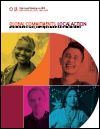
Resource | Publications,
Four decades after the first cases of AIDS were reported, new data from UNAIDS show that dozens of countries achieved or exceed the 2020 targets set by the United Nations General Assembly in 2016—evidence that the targets were not just aspirational but achievable.
The report shows that countries with progressive laws and policies and strong and inclusive health systems have had the best outcomes against HIV. In those countries, people living with and affected by HIV are more likely to have access to effective HIV services, including HIV testing, pre-exposure prophylaxis (medicine to prevent HIV), harm reduction, multimonth supplies of HIV treatment and consistent, quality follow-up and care.
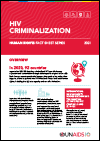
Resource | Fact Sheets,
The 2021-2026 Global AIDS Strategy has bold and critical new targets on realizing human rights, reducing stigma, discrimination and violence and removing harmful punitive laws as a pathway to ending inequalities and ultimately ending AIDS. To aid in the scale up of interventions to remove these societal barriers, UNAIDS has produced a series of fact sheets on human rights in various areas, highlighting the critical need to scale up action on rights. They are a series of short, easy to digest and accessible documents outlining the latest epidemiology, the evidence of the impact of human rights interventions, the latest targets, and international guidelines, recommendations and human rights obligations relating to each topic. Fact sheets released in June 2021: HIV criminalization, HIV and people who use drugs, HIV and gay men and who have sex with other men, HIV and transgender and other gender-diverse people, HIV and sex work, HIV and people in prisons and other closed settings and HIV and stigma and discrimination.
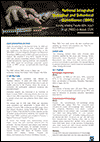
Resource | Fact Sheets,
NCASC conducted a nation-wide descriptive cross-sectional survey among people who inject drugs (PWID) in all Provinces of Nepal to generate both national and subnational HIV estimates.
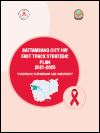
Resource | Publications,
This Fast-Track City Strategic Plan for Battambang is the first provincial/city-level HIV strategy developed in Cambodia. As a matter of principle, the Fast-Track strategy aimed to be in line with the priorities and targets set out by the National AIDS Authority (NAA) and the National Centre for HIV/AIDS, Dermatology and STD (NCHADS), especially the 95-95-95 targets and the aim to end AIDS as a public health threat by 2025. These targets and priorities were then translated and adapted to the specific situation of Battambang Province in general, and to Battambang City in particular.
This strategic plan will be useful guidance for the HIV response in Battambang, helping to ensure Battambang is reaching the 95-95-95 targets and ending AIDS as a public health threat by 2025 in line with RGC’s commitment.
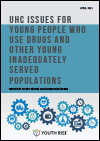
Resource | Publications,
Achieving Universal Health Coverage (UHC) is a goal we should all be striving for. Across the world, countless people are suffering unnecessary harm and death as a result of lack of access to affordable, necessary healthcare. While all of us suffer to varying degrees when healthcare is not universally available, it is the most marginalized in our societies who are impacted the most. As a young transgender woman who uses drugs my communities are among those most impacted by lack of access to healthcare. Young Inadequately Served Populations (ISPs), particularly in the Global South, are the communities who are going to continue to be left behind if we do not achieve UHC.
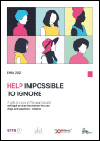
Resource | Publications,
The purpose of this publication is to provide guidance for professionals working in both governmental and non-governmental organisations (NGOs) offering comprehensive care for women who use drugs and experience gender-based violence (GBV).
The guide is also intended for use by organisations involved in harm reduction, HIV prevention, treatment, care and support, and by those that undertake to address and respond to gender-based violence against women.
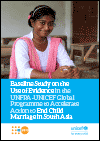
Resource | Publications,
This study was conducted in Bangladesh, India and Nepal at the start of Phase II (2020-2023) to establish a baseline measuring the programme’s use of evidence in programming, design and delivery, advocacy and monitoring and evaluation (M&E). The study also reviews the major activities outlined in the Phase II Work Plans for the three countries. The study develops a set of core indicators and tools for measuring the use of evidence that can be replicated at the mid-term and at the end of Phase II.

Resource | Publications,
Demand for data on the prevalence of violence against women (VAW) is increasing as countries monitor their progress towards meeting Sustainable Development Goal (SDG) 5 for Gender Equality and Women’s Empowerment and other commitments such as the Convention on the Elimination of All Forms of Discrimination against Women (CEDAW). Yet, due to limited technical capacities, data on VAW prevalence are often unavailable, underused or collected in unethical, unreliable, and incomparable ways.
To address this void in ethical, reliable, and comparable VAW prevalence data across Asia and the Pacific, the kNOwVAWdata Initiative was launched in 2016 by UNFPA Asia and the Pacific Regional Office (APRO) with financial support from the Australian Government Department of Foreign Affairs and Trade (DFAT). With University of Melbourne and Australia’s National Research Organisation for Women’s Safety (ANROWS) as key partners, the kNOwVAWdata Initiative aimed to improve the availability and quality of data to inform more effective policy and programme responses to end VAW.
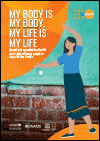
Resource | Publications,
This review provides an update to the 2015 report highlighting the current status of young people’s sexual and reproductive health and rights (SRHR) and examines key SRHR priorities in Asia and the Pacific to support informed policy, programming and advocacy.
This review has a particular focus on current evidence, policy and programme approaches related to key SRHR priorities in the region: child marriage and early union; adolescent pregnancy; young people with diverse sexual orientation and gender identity; SRH in a digital age; comprehensive sexuality education; and universal health coverage for adolescent SRH.
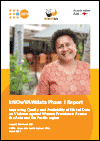
Resource | Publications,
Violence against women is recognized as a global public policy priority. Yet, despite growing awareness of the causes and consequences of violence against women, limited high-quality, actionable data on its prevalence exist. This gap is largely due to countries’ inadequate technical capacities to measure violence against women prevalence, meaning they rely on international experts, of whom there are not enough to meet the current and growing needs.





